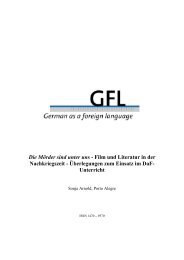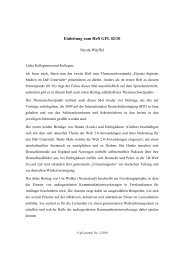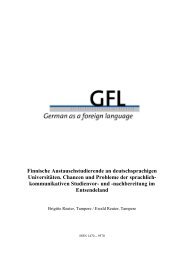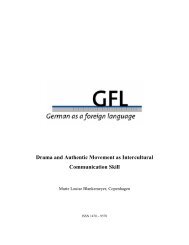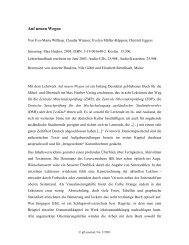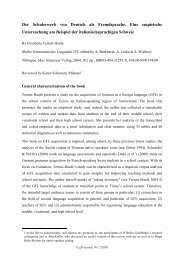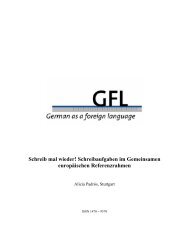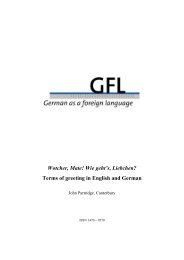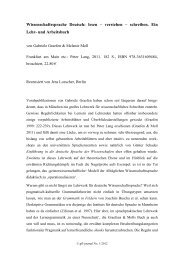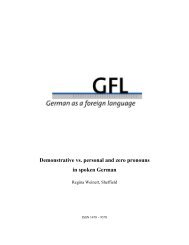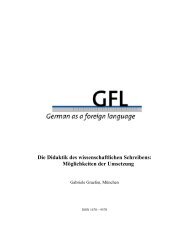Dramagrammar in Theory and Practice - GFL-Journal
Dramagrammar in Theory and Practice - GFL-Journal
Dramagrammar in Theory and Practice - GFL-Journal
You also want an ePaper? Increase the reach of your titles
YUMPU automatically turns print PDFs into web optimized ePapers that Google loves.
<strong>Dramagrammar</strong> <strong>in</strong> <strong>Theory</strong> <strong>and</strong> <strong>Practice</strong><br />
Susanne Even, Worcester<br />
ISSN 1470 – 9570
<strong>Dramagrammar</strong> <strong>in</strong> <strong>Theory</strong> <strong>and</strong> <strong>Practice</strong><br />
35<br />
<strong>Dramagrammar</strong> <strong>in</strong> <strong>Theory</strong> <strong>and</strong> <strong>Practice</strong><br />
Susanne Even, Worcester<br />
This article is composed of two separate, although overlapp<strong>in</strong>g, conference contributions, a<br />
paper <strong>and</strong> a workshop. Part I, the paper, <strong>in</strong>troduces the concept of dramagrammar (drama <strong>in</strong><br />
education for grammar teach<strong>in</strong>g) <strong>and</strong> outl<strong>in</strong>es its genesis <strong>in</strong> the context of third-level foreign<br />
language teach<strong>in</strong>g <strong>in</strong> Brita<strong>in</strong> <strong>and</strong> Irel<strong>and</strong>. Traditional problems of foreign language grammar<br />
teach<strong>in</strong>g are described <strong>and</strong> solutions from dramagrammar are offered. A prototypical model<br />
of the dramagrammar lesson follows. Part II, the workshop, describes a practical<br />
dramagrammar session that took place at the conference. Mov<strong>in</strong>g from pantomime to<br />
dramatic play, workshop participants experienced dramagrammar as the <strong>in</strong>herently social<br />
activity that it is.<br />
I. <strong>Dramagrammar</strong> as one possible solution to problematic aspects of the<br />
teach<strong>in</strong>g <strong>and</strong> learn<strong>in</strong>g of foreign language grammar.<br />
1. Introduction<br />
<strong>Dramagrammar</strong>, or drama <strong>in</strong> education for grammar teach<strong>in</strong>g, is a holistic teach<strong>in</strong>g <strong>and</strong><br />
learn<strong>in</strong>g approach that is closely connected with dramatic art forms. The idea of<br />
dramagrammar was derived from Manfred Schewe’s <strong>in</strong>novative teach<strong>in</strong>g concept of drama<br />
<strong>in</strong> education for foreign language teach<strong>in</strong>g <strong>and</strong> learn<strong>in</strong>g (Schewe 1993).<br />
Through drama techniques, grammar is experienced <strong>in</strong> h<strong>and</strong>s-on situations that simulate<br />
reality. Students encounter contexts that require language <strong>in</strong> use <strong>and</strong>, at the same time, raise<br />
their awareness about appropriate l<strong>in</strong>guistic structures. In other words, dramagrammar is<br />
concerned not only with what students say but also with how they say it. Fictional contexts<br />
<strong>in</strong>spire fantasy <strong>and</strong> creativity; students are relieved of their usual roles <strong>and</strong> responsibilities<br />
<strong>and</strong> can enjoy the ‘freedom of be<strong>in</strong>g somebody else’.<br />
Work<strong>in</strong>g with drama means <strong>in</strong>corporat<strong>in</strong>g <strong>in</strong>to the learn<strong>in</strong>g process not only cognitive<br />
faculties but also other factors that have traditionally played a far lesser role <strong>in</strong> language<br />
teach<strong>in</strong>g. K<strong>in</strong>aesthetic, social, emotional <strong>and</strong> empathic learn<strong>in</strong>g moments make for<br />
© gfl-journal, No. 1/2004
Susanne Even<br />
36<br />
<strong>in</strong>tensive <strong>and</strong> last<strong>in</strong>g experiences with the foreign language, grammar, literature <strong>and</strong><br />
culture.<br />
2. Grammar: A Bl<strong>in</strong>d Spot<br />
The communicative approach of the last decades changed the nature of language teach<strong>in</strong>g.<br />
It overrode both the stilted grammar-translation exercises <strong>and</strong> the imitative drills of the<br />
audio-l<strong>in</strong>gual method. However, the trend of communicative language teach<strong>in</strong>g has had its<br />
problematic aspects as well. Very often, grammar has been either completely neglected <strong>in</strong><br />
schools <strong>and</strong> colleges, or taught <strong>in</strong> a rather ad hoc way, its ma<strong>in</strong> focus be<strong>in</strong>g the provision of<br />
communicative skills, with disregard for basic structures. And despite a general target of<br />
‘communicative competence’, pupils have ended up with very limited foreign language<br />
skills, which all too often consist of the recital of their names, ages, places of residence,<br />
brothers <strong>and</strong> sisters, hobbies, favourite foods, <strong>and</strong> pets. At university level, we now reap the<br />
fruits of foreign language <strong>in</strong>struction be<strong>in</strong>g reduced to communicative bits <strong>and</strong> pieces.<br />
Young people com<strong>in</strong>g to university with a sound grammatical knowledge are the exception;<br />
the majority have an <strong>in</strong>consistent <strong>and</strong> scanty knowledge of grammar. It has <strong>in</strong>creas<strong>in</strong>gly<br />
become the job of universities to rectify this (cf. Durrell 1993:56).<br />
When I taught at the University of Leicester, my teach<strong>in</strong>g load featured a lot of oral<br />
workshops, small groups <strong>in</strong> which ‘conversation’ <strong>in</strong> the foreign language was supposed to<br />
take place 1 . In these classes, I was able to observe the effect of traditional grammar lessons<br />
on actual language production. Despite students’ weekly grammar lessons with committed<br />
colleagues, little ‘stuck’. Only <strong>in</strong> a very few cases could students convert cognitively learnt<br />
structures <strong>in</strong>to appropriate l<strong>in</strong>guistic action. What is more, my colleagues deplored the fact<br />
that they taught the second year students more or less the same material aga<strong>in</strong> as <strong>in</strong> the first<br />
year, so that hardly any long-term success was achieved. Discussions with other colleagues<br />
<strong>in</strong> Brita<strong>in</strong> <strong>and</strong> Irel<strong>and</strong> confirmed this impression.<br />
1 On the critical evaluation of the practice of conversation classes, cf. Schewe 1993:20-22.<br />
© gfl-journal, No. 1/2004
<strong>Dramagrammar</strong> <strong>in</strong> <strong>Theory</strong> <strong>and</strong> <strong>Practice</strong><br />
37<br />
The follow<strong>in</strong>g becomes clear at this po<strong>in</strong>t: the problem is not that university students are<br />
taught no grammar. On the contrary, grammar <strong>in</strong> the traditional sense is taught cont<strong>in</strong>ually<br />
on a weekly basis. What is more, almost all students have access to computer-assisted<br />
language learn<strong>in</strong>g facilities. Although there would be no sense <strong>in</strong> claim<strong>in</strong>g that these<br />
grammar lessons showed no results whatsoever, it should nevertheless be asked why their<br />
success, consider<strong>in</strong>g all time <strong>and</strong> effort spent, rema<strong>in</strong>s at such a modest level. In all too<br />
many cases students fail to master the transition from theoretical l<strong>in</strong>guistic knowledge to its<br />
adequate realization <strong>in</strong> communication.<br />
Most students are aware of their lack of grammatical competence. Their l<strong>in</strong>guistic<br />
uneas<strong>in</strong>ess manifests itself <strong>in</strong> the desire for ‘more grammar, more homework, more tests’ –<br />
an attempt to replace one evil with another. This outlook on learn<strong>in</strong>g is mechanistic, based<br />
on the idea of <strong>in</strong>put <strong>and</strong> output: the more grammatical facts are crammed <strong>in</strong>to students’<br />
heads, the more they will know <strong>and</strong> the better their grades will be. The observation that<br />
acquir<strong>in</strong>g grammatical facts was, <strong>in</strong> fact, often unrelated to real language acquisition was<br />
my start<strong>in</strong>g po<strong>in</strong>t <strong>in</strong> the search for different approaches to grammar teach<strong>in</strong>g.<br />
Let me br<strong>in</strong>g the discrepancy between grammatical knowledge <strong>and</strong> l<strong>in</strong>guistic ability <strong>in</strong>to<br />
sharper focus by the follow<strong>in</strong>g observations:<br />
2.1 Traditional Instruction<br />
Grammar lessons are more often than not a completely cognitive exercise. Usually the<br />
teacher st<strong>and</strong>s <strong>in</strong> front of a blackboard, present<strong>in</strong>g grammatical phenomena us<strong>in</strong>g grammar<br />
book, projector, <strong>and</strong> chalk, followed by various written exercises from the grammar book.<br />
Sometimes problem areas <strong>in</strong> students’ essays or translation exercises might lead to a<br />
discussion of a specific grammatical problem. We have all, at some time or other, taught<br />
this way – sometimes with a somewhat guilty conscience when remember<strong>in</strong>g the range of<br />
‘alternative’ teach<strong>in</strong>g <strong>and</strong> learn<strong>in</strong>g methods ‘out there’ 2 . However, there is a reason for<br />
teachers cont<strong>in</strong>ually fall<strong>in</strong>g back on traditional grammar <strong>in</strong>struction. Traditional grammar<br />
lessons have the advantage of allow<strong>in</strong>g teachers to go through a lot of material <strong>in</strong> a<br />
2 For a detailed analysis of alternative teach<strong>in</strong>g <strong>and</strong> learn<strong>in</strong>g methods cf. Ortner 1998 <strong>and</strong><br />
Schlemm<strong>in</strong>ger et al. 2000.<br />
© gfl-journal, No. 1/2004
Susanne Even<br />
38<br />
comparatively short time, <strong>and</strong> both students <strong>and</strong> teachers get the impression that grammar<br />
has been taught ‘properly’ <strong>and</strong> a result has been achieved.<br />
2.2 Low Status<br />
It is implicitly assumed that everyone can teach grammar. University lecturers (unless they<br />
have a specific didactic <strong>in</strong>terest) often like to delegate language <strong>and</strong> grammar lessons to<br />
lectors <strong>and</strong> language tutors. Grammar lessons have a lower status compared with lectures<br />
on literature, l<strong>in</strong>guistics <strong>and</strong> area studies. Deal<strong>in</strong>g with the problems <strong>and</strong> challenges of<br />
teach<strong>in</strong>g grammar is not necessarily regarded as a form of serious research.<br />
Correspond<strong>in</strong>gly, <strong>in</strong> most cases there are hardly any specific <strong>in</strong>structions as to how<br />
grammar can be taught <strong>in</strong> a more mean<strong>in</strong>gful way.<br />
2.3 ‘We don’t have enough grammar!’<br />
Students deplore their lack of grammatical knowledge, but also do not know how to go<br />
about rectify<strong>in</strong>g it. Interest<strong>in</strong>gly enough, the above quotation highlights the misconception<br />
that grammar is a possession that can be acquired as a complete package deal that students<br />
can ‘have’ – rather than an ability, whose use exp<strong>and</strong>s the abundance of expressions <strong>and</strong> the<br />
fun with the foreign language. Consequently, grammar simply rema<strong>in</strong>s a system of<br />
unrelated rules, the relevance of which is barely seen <strong>in</strong> actual communicative situations.<br />
2.4 Inconsistent Attitudes<br />
Judg<strong>in</strong>g by my experiences, grammar is very high on students’ scale of priorities <strong>and</strong> is, at<br />
the same time, very low on their popularity scale 3 . They “k<strong>in</strong>da” see the necessity of<br />
grammatical knowledge, yet all too often they don’t know what to do or they don’t want to<br />
do it, hav<strong>in</strong>g had negative experiences with grammar <strong>in</strong> school 4 . This attitude often goes<br />
together with the conviction that foreign language grammar is firstly <strong>in</strong>credibly difficult<br />
3 Empirical <strong>in</strong>vestigations by Zimmermann (1995:184) <strong>in</strong>to pupils’ <strong>and</strong> adults’ views on grammar<br />
support this. He talks of an “<strong>in</strong>consistent <strong>and</strong> at the same time conflict<strong>in</strong>g attitude” or “divided<br />
attitudes”.<br />
4 On negative attitudes towards grammar <strong>and</strong> grammar lessons cf. Zimmermann 1995 <strong>and</strong> Mannix<br />
(<strong>in</strong> preparation).<br />
© gfl-journal, No. 1/2004
<strong>Dramagrammar</strong> <strong>in</strong> <strong>Theory</strong> <strong>and</strong> <strong>Practice</strong><br />
39<br />
<strong>and</strong> secondly <strong>in</strong>credibly important <strong>and</strong> only when, as if by magic, grammar has ‘actually’<br />
been understood, can (<strong>and</strong> would) they speak.<br />
2.5 The Year Abroad<br />
The Year Abroad, which broadens oral competence immensely, does not automatically<br />
br<strong>in</strong>g about an improvement <strong>in</strong> grammatical knowledge. Accord<strong>in</strong>g to an <strong>in</strong>vestigation by<br />
Riana Walsh (1998) at University College Dubl<strong>in</strong>, success <strong>in</strong> learn<strong>in</strong>g grammar by stay<strong>in</strong>g<br />
<strong>in</strong> the target country for six months or a year is m<strong>in</strong>imal, though this is often compensated<br />
for by <strong>in</strong>creased oral fluency <strong>and</strong> ref<strong>in</strong>ed avoidance strategies. Usually, students who have<br />
previously shown <strong>in</strong>terest <strong>in</strong> grammar also profit from the experience abroad <strong>in</strong> a<br />
grammatical sense – whereas those who have found that foreign language grammar means<br />
noth<strong>in</strong>g to them <strong>in</strong> the first two years of study, will still be <strong>in</strong> grammatical trouble after the<br />
year abroad, both <strong>in</strong> oral <strong>and</strong> written work.<br />
2.6 Silence<br />
In most British schools, the motto all too often is ‘be quiet <strong>and</strong> listen to the teacher’.<br />
Mistakes are deemed undesirable, <strong>and</strong> it is the ability to learn someth<strong>in</strong>g off by heart that is<br />
tested <strong>in</strong> exam<strong>in</strong>ations. Correspond<strong>in</strong>gly, students tend to feel completely overtaxed when<br />
they advance to university with its emphasis on the ability to th<strong>in</strong>k critically, run <strong>in</strong>telligent<br />
risks <strong>and</strong> transfer knowledge onto new situations. And s<strong>in</strong>ce we all tend to deal with<br />
problems as we have done <strong>in</strong> the past (even if this method has been counterproductive),<br />
students do just that: they simply fall silent – or stay away from lessons. For fear of<br />
mak<strong>in</strong>g a mistake, many avoid speak<strong>in</strong>g altogether – an attitude that naturally drives many<br />
foreign language teachers to distraction.<br />
2.7 Skepticism<br />
Learn<strong>in</strong>g techniques <strong>and</strong> strategies that promote autonomous learn<strong>in</strong>g are not only less well<br />
known but are often rejected, not only by students but by teachers as well. The well-known<br />
counterargument is that ‘you don’t learn enough’ us<strong>in</strong>g such methods. ‘Learn<strong>in</strong>g’ is seen as<br />
the accumulation <strong>and</strong> reproduction of factual knowledge, not as a process of analysis <strong>and</strong><br />
© gfl-journal, No. 1/2004
Susanne Even<br />
40<br />
criticism. Students’ l<strong>in</strong>guistic success is measured <strong>in</strong> ‘gett<strong>in</strong>g it right’, not as an ability to do<br />
the best with one’s current knowledge <strong>and</strong> go<strong>in</strong>g on from there.<br />
To sum up: grammar is regarded as an <strong>in</strong>tegral part of university studies <strong>in</strong> foreign<br />
languages, but the quality <strong>and</strong> methods of grammar teach<strong>in</strong>g are rarely reflected upon.<br />
Foreign language teachers generally use traditional methods of grammar <strong>in</strong>struction rather<br />
than learn<strong>in</strong>g styles that promote autonomy. Despite a regular supply of grammar lessons,<br />
students’ knowledge rema<strong>in</strong>s sketchy <strong>and</strong> is seldom translated <strong>in</strong>to appropriate foreign<br />
language production. Even prolonged residence <strong>in</strong> the target country does not necessarily<br />
lead to a marked improvement <strong>in</strong> grammatical competence.<br />
3. <strong>Dramagrammar</strong> Teach<strong>in</strong>g<br />
After this broad overview of the ‘grammar <strong>in</strong>struction reality’ at many universities <strong>in</strong><br />
Irel<strong>and</strong> <strong>and</strong> Brita<strong>in</strong>, I would now like to <strong>in</strong>troduce a model of the dramagrammar lesson.<br />
The typical course of a dramagrammar session can be presented <strong>in</strong> six teach<strong>in</strong>g phases:<br />
• The phase of awareness-rais<strong>in</strong>g <strong>in</strong>troduces situations that require the use of specific<br />
grammatical structures that make learners aware of these structures (or of their lack<br />
thereof). As an example: a scarf is h<strong>and</strong>ed around from student to student <strong>in</strong> different<br />
ways, depend<strong>in</strong>g on what it is supposed to be (a baby? a hot fry<strong>in</strong>g-pan? the crown<br />
jewels?). Students are supposed to ask the next person <strong>in</strong> a polite way to take the<br />
respective object from their h<strong>and</strong>s (“could you please …?” / “would you be so k<strong>in</strong>d as<br />
to …” / “might it be possible that …”), thus <strong>in</strong>troduc<strong>in</strong>g, practis<strong>in</strong>g or re<strong>in</strong>forc<strong>in</strong>g the<br />
subjunctive for use <strong>in</strong> polite speech.<br />
• In the context-f<strong>in</strong>d<strong>in</strong>g phase learners work on real-life contexts <strong>in</strong> which these<br />
structures are put <strong>in</strong>to concrete use <strong>in</strong> the form of short dramatic improvisations. The<br />
scene could now be a street, a dat<strong>in</strong>g bar, a petrol station etc. where requests are made<br />
<strong>and</strong> have to be acted upon.<br />
• The l<strong>in</strong>guistic phase cognitively exam<strong>in</strong>es forms <strong>and</strong> functions of the grammatical<br />
structures <strong>in</strong> question. This phase consciously <strong>in</strong>terrupts the dramatic flow. Explicit<br />
© gfl-journal, No. 1/2004
<strong>Dramagrammar</strong> <strong>in</strong> <strong>Theory</strong> <strong>and</strong> <strong>Practice</strong><br />
41<br />
exam<strong>in</strong>ation of grammar is put <strong>in</strong> the middle of the dramagrammar lesson <strong>in</strong>stead of at<br />
the beg<strong>in</strong>n<strong>in</strong>g, the advantage be<strong>in</strong>g that learners have already experienced the need for<br />
us<strong>in</strong>g certa<strong>in</strong> structures. Their focus on grammar will now be deliberate <strong>and</strong><br />
purposeful. Ideas from the former phases are taken up <strong>and</strong> possible l<strong>in</strong>guistic<br />
realizations are exam<strong>in</strong>ed. This is a collaborative activity; the teacher guides the<br />
learners towards work<strong>in</strong>g out grammatical forms <strong>and</strong> rules themselves. Only <strong>in</strong> the end<br />
does s/he summarize the results <strong>and</strong> settle open questions. In the case of the<br />
subjunctive, polite requests (“could you please…”) <strong>and</strong> wishes (“I would really like to<br />
…”) should be dealt with together s<strong>in</strong>ce they are very close <strong>in</strong> mean<strong>in</strong>g; this could<br />
easily lead to the dist<strong>in</strong>ction between reality (<strong>in</strong>dicative) versus unreality (subjunctive).<br />
Depend<strong>in</strong>g on their competence, this phase is conducted either <strong>in</strong> the target language or<br />
<strong>in</strong> the students’ mother tongue.<br />
• The phase of dramatic play broadens contextual <strong>and</strong> structural knowledge. The<br />
grammatical phenomena are now be<strong>in</strong>g worked on dramatically; student groups design<br />
<strong>and</strong> rehearse longer, <strong>in</strong>-depth dramatic improvisations featur<strong>in</strong>g the new structures.<br />
Draw<strong>in</strong>g on the above examples, elaboration could take the form of just about any<br />
issue <strong>in</strong> which an agreement has to be reached (e.g. plann<strong>in</strong>g an excursion for a family<br />
whose members have very different ideas of what to do, or a conduct<strong>in</strong>g a discussion<br />
between parents <strong>and</strong> teenagers about career options <strong>and</strong> plans for the future, etc.)<br />
• Dur<strong>in</strong>g the presentation phase the learners take the stage <strong>and</strong> make their dramatic<br />
improvisations public to the other participants.<br />
• The dramagrammar session ends with a reflection phase <strong>in</strong> which learners have the<br />
opportunity to settle open questions, talk about what worked, what didn’t, <strong>and</strong> why. It<br />
is a forum for language awareness <strong>and</strong> language learn<strong>in</strong>g reflection.<br />
I taught dramagrammar over the course of a full academic year to a second-year group of<br />
students at the University of Leicester. Regular discussions with them about the modus<br />
oper<strong>and</strong>i as well as f<strong>in</strong>al <strong>in</strong>terviews at the end of the year yielded encourag<strong>in</strong>g feedback<br />
about dramagrammar:<br />
© gfl-journal, No. 1/2004
Susanne Even<br />
42<br />
• Psychologically, students po<strong>in</strong>ted out that they were less afraid of mak<strong>in</strong>g mistakes <strong>and</strong><br />
more <strong>in</strong>cl<strong>in</strong>ed to take risks. They felt more self-assured <strong>and</strong> motivated, <strong>and</strong> enjoyed<br />
work<strong>in</strong>g closely with the other students, thereby form<strong>in</strong>g deeper connections <strong>and</strong><br />
friendships.<br />
• Pedagogically, students experienced grammar <strong>in</strong> immediate use, which means that they<br />
understood it not only cognitively but also contextually, with m<strong>in</strong>d as well as body,<br />
<strong>and</strong> <strong>in</strong> real-life situations – by listen<strong>in</strong>g to others, react<strong>in</strong>g to what they said, mak<strong>in</strong>g<br />
verbal <strong>and</strong> non-verbal contributions that were significant to the ongo<strong>in</strong>g dramatic<br />
situation. In the words of a student:<br />
I used to see grammar as a very dry, factual be<strong>in</strong>g imprisoned on paper <strong>and</strong> th<strong>in</strong>gs. It seems<br />
to have got off the paper <strong>and</strong> <strong>in</strong>to my head a bit more now. Into real life. Obviously we’ve<br />
always known that it’s important for communicat<strong>in</strong>g <strong>in</strong> reality, <strong>in</strong> real situations but I th<strong>in</strong>k<br />
there’s a difference between know<strong>in</strong>g someth<strong>in</strong>g <strong>and</strong> realis<strong>in</strong>g it. (Tim K.)<br />
The students also made steps towards learn<strong>in</strong>g autonomy by start<strong>in</strong>g to self-monitor their<br />
own language learn<strong>in</strong>g process.<br />
Students professed themselves as be<strong>in</strong>g much more at ease with the whole topic of<br />
grammar <strong>and</strong> more <strong>in</strong>cl<strong>in</strong>ed to tackle grammatical phenomena <strong>in</strong> the foreign language.<br />
Their attitude to grammar had changed markedly to the positive:<br />
I wouldn’t say I was completely confident about all the th<strong>in</strong>gs we’ve done so far but I’m<br />
confident that I can actually learn it now, whereas before it was a massive mounta<strong>in</strong> of<br />
grammar… (Jon M.)<br />
Well, before grammar was someth<strong>in</strong>g… you sat down with a text book <strong>and</strong> thought ‘right, ok<br />
I’m go<strong>in</strong>g to learn this. I’m go<strong>in</strong>g to do the exercises <strong>and</strong> then hopefully I’ll know it <strong>and</strong> if I<br />
don’t then I have to do more exercises to learn it.’ And now grammar is less of a chore.<br />
Maybe it’s just because I do know more but it just felt as if we weren’t really learn<strong>in</strong>g,<br />
unconsciously learn<strong>in</strong>g, so <strong>in</strong> that respect it’s changed my perspective on grammar. Before it<br />
was ‘oh God I must know that, I’ll have to sit down <strong>and</strong> learn it’ <strong>and</strong> now I th<strong>in</strong>k I don’t have<br />
to do that any more <strong>and</strong> I can just ask other people <strong>and</strong> have fun with it. [...] I th<strong>in</strong>k grammar<br />
doesn’t have to be bor<strong>in</strong>g like it was before, I th<strong>in</strong>k my whole attitude has changed now. It’s<br />
less of ‘I don’t want to sit down <strong>and</strong> do that th<strong>in</strong>g’, it’s do<strong>in</strong>g someth<strong>in</strong>g with it. (Julie T.)<br />
<strong>Dramagrammar</strong> is a comb<strong>in</strong>ation of language <strong>in</strong> use <strong>and</strong> language reflection. It <strong>in</strong>tegrates<br />
dramatic act<strong>in</strong>g with conscious language analysis. On the one h<strong>and</strong>, <strong>in</strong>teraction <strong>in</strong> context<br />
© gfl-journal, No. 1/2004
<strong>Dramagrammar</strong> <strong>in</strong> <strong>Theory</strong> <strong>and</strong> <strong>Practice</strong><br />
43<br />
<strong>and</strong> negotiation of mean<strong>in</strong>g propel language acquisition forward; on the other h<strong>and</strong>, explicit<br />
grammar <strong>in</strong>struction provides a firm anchorage of structures.<br />
Traditional grammar knowledge is all too often ‘dead knowledge’, devoid of actual<br />
mean<strong>in</strong>g <strong>in</strong> the real world, <strong>and</strong> only good for pass<strong>in</strong>g decontextualized exams. In contrast,<br />
dramagrammatical knowledge is practical <strong>and</strong> contextualized. It starts with concrete social<br />
situations that lead <strong>in</strong>to <strong>in</strong>tensive language analysis which is then fed back <strong>in</strong>to mean<strong>in</strong>gful<br />
language use <strong>in</strong> dramatic play. This dramagrammatical knowledge affords students added<br />
problem-solv<strong>in</strong>g skills <strong>and</strong> strategies that are also highly useful <strong>in</strong> exam situations.<br />
<strong>Dramagrammar</strong> takes place <strong>in</strong> a social sett<strong>in</strong>g <strong>and</strong> requires teamwork – both <strong>in</strong>teractive<br />
negotiation of mean<strong>in</strong>g <strong>and</strong> l<strong>in</strong>guistic analysis take place <strong>in</strong> self-organized groups. The<br />
language teacher is not so much the ‘fount of knowledge’ as s/he is a supporter <strong>and</strong> guide,<br />
tak<strong>in</strong>g up ideas <strong>and</strong> advis<strong>in</strong>g people how to put them <strong>in</strong>to play, or help<strong>in</strong>g to work out<br />
grammar learn<strong>in</strong>g strategies. This approach especially accommodates the requirements of<br />
adult learners who strive towards hav<strong>in</strong>g control of their own learn<strong>in</strong>g process.<br />
II. Workshop: Rumour – gossip – hearsay: Reported speech <strong>in</strong> the<br />
dramagrammar classroom.<br />
<strong>Dramagrammar</strong> is an <strong>in</strong>herently social activity that takes place <strong>in</strong> <strong>and</strong> with a group of<br />
learners. It is therefore difficult to communicate <strong>in</strong> a theoretical paper the full sense of how<br />
dramagrammar works <strong>in</strong> practice. In order to impart a general idea of how grammatical<br />
structures can be taught through dramagrammar, I chose to also offer a prototypical<br />
dramagrammar workshop on <strong>in</strong>direct (reported) speech, designed for advanced language<br />
students. Even though it is not possible to capture the dynamics <strong>and</strong> the fun of the actual<br />
dramagrammar session <strong>in</strong> situ, I shall hereby present its outl<strong>in</strong>e <strong>in</strong> condensed form.<br />
In the past, I have offered this workshop to teachers of German. S<strong>in</strong>ce the workshop<br />
participants at this conference were speakers <strong>and</strong> teachers of different languages, but all<br />
spoke English, I chose English as the language to be taught <strong>and</strong> adapted the workshop<br />
accord<strong>in</strong>gly.<br />
© gfl-journal, No. 1/2004
Susanne Even<br />
44<br />
1. Awareness-rais<strong>in</strong>g – Pantomime<br />
Chairs are set <strong>in</strong> pairs around a “stage” (presentation space). One chair of each pair is<br />
turned around so that the person sitt<strong>in</strong>g on it is fac<strong>in</strong>g away from the stage. The group is<br />
also divided <strong>in</strong>to pairs, with each consist<strong>in</strong>g of an “observer” who looks at the stage, <strong>and</strong> a<br />
“listener” who faces away from it. The teacher announces an exercise <strong>in</strong> three parts:<br />
Part 1: The teacher enters the room as Teacher <strong>in</strong> Role 5 <strong>and</strong> performs a short pantomime 6 ,<br />
wear<strong>in</strong>g a mask 7 . In the foreign language, the observers then describe the teacher’s<br />
actions <strong>in</strong> as much detail as possible to the listeners, who are unable to see those<br />
actions for themselves.<br />
Part 2: All the chairs now face the front. The teacher enters the room aga<strong>in</strong>, but waits just<br />
<strong>in</strong>side the door. The previous pantomime is then recreated by the listeners, who tell<br />
the teacher what to do <strong>and</strong> how to move. The teacher follows their cues.<br />
Part 3: Everybody is sitt<strong>in</strong>g <strong>in</strong> a circle. The observers are called to describe the differences<br />
between the teacher’s orig<strong>in</strong>al pantomime <strong>and</strong> the one later recreated accord<strong>in</strong>g to<br />
the listeners’ directions. The participants are encouraged to use reported speech, e.g.<br />
I told John that the person was walk<strong>in</strong>g around for a while until she sat down, but<br />
John said she immediately sat down. Then the teacher performs the orig<strong>in</strong>al<br />
pantomime aga<strong>in</strong>. Everybody observes closely. Afterwards, the listeners tell the<br />
observers what they didn’t tell them, e.g. Alex, you said she was touch<strong>in</strong>g up her<br />
make-up but you didn’t tell me how – that she reapplied lipstick, p<strong>in</strong>ched her cheeks<br />
etc.<br />
5 The drama technique Teacher <strong>in</strong> Role is expla<strong>in</strong>ed <strong>in</strong> Even 2003:166f.<br />
6 The pantomime can be any short scene that would open itself to <strong>in</strong>terpretation. In this workshop, I<br />
walked <strong>in</strong>to the room with a sw<strong>in</strong>g<strong>in</strong>g step, took a few dance steps, <strong>and</strong> eventually sat down on the<br />
chair straighten<strong>in</strong>g my clothes <strong>and</strong> touch<strong>in</strong>g up my make-up. After a while I started look<strong>in</strong>g at my<br />
watch, look<strong>in</strong>g at the door, drumm<strong>in</strong>g my f<strong>in</strong>gers. The phone rang <strong>and</strong> I jumped up to answer it.<br />
While I was listen<strong>in</strong>g, my shoulders drooped <strong>and</strong> I looked at the floor. I hung up the phone <strong>and</strong><br />
discovered a written note. I took it out of its envelope <strong>and</strong> read it. I let it fall to the floor, got up <strong>and</strong><br />
slowly shuffled to the door. I turned around, looked at the letter on the floor aga<strong>in</strong>, went back,<br />
picked it up <strong>and</strong> tore it <strong>in</strong>to pieces before I left the room.<br />
7 S<strong>in</strong>ce the masks hides facial expressions, the observers are forced to pay close attention to body<br />
language.<br />
© gfl-journal, No. 1/2004
<strong>Dramagrammar</strong> <strong>in</strong> <strong>Theory</strong> <strong>and</strong> <strong>Practice</strong><br />
45<br />
In this exercise the participants have to either describe a sequence of events (observers) or<br />
retell someth<strong>in</strong>g that has been told to them (listeners). Everybody will be aware of how<br />
much orig<strong>in</strong>al <strong>and</strong> copy differ. The observers will experience how difficult it is to stick to<br />
what is seen on stage <strong>and</strong> not immediately jump to <strong>in</strong>terpretations (“her body slumps<br />
down”, as opposed to “she looks sad”). The listeners might feel the need to defend their<br />
descriptions <strong>and</strong> make clear that they were only repeat<strong>in</strong>g what they themselves had been<br />
told.<br />
2. L<strong>in</strong>guistic Phase – Grammar talk<br />
The above conversation leads <strong>in</strong>to a discussion of <strong>in</strong>direct / reported speech. The teacher<br />
chooses a few examples from the former exchanges <strong>and</strong> writes them on the blackboard. In<br />
small groups, the participants are encouraged to exam<strong>in</strong>e the grammatical structures of the<br />
examples, work out the rules of <strong>in</strong>direct speech <strong>and</strong> / or apply previously learnt grammar<br />
rules to the examples. Each group writes their results (<strong>and</strong> their questions!) on large pieces<br />
of paper <strong>and</strong> presents them afterwards to the whole group.<br />
Nota bene: Different foreign languages have different ways of deal<strong>in</strong>g with reported speech<br />
(tense-shifts, forms of the subjunctive). Consequently, this phase of l<strong>in</strong>guistic exam<strong>in</strong>ation<br />
needs to be carefully prepared <strong>in</strong> terms of language, previous grammatical knowledge,<br />
<strong>in</strong>tended time spent on explicit grammar, <strong>and</strong> <strong>in</strong>tended depth of grammatical <strong>in</strong>sight.<br />
3. Context-f<strong>in</strong>d<strong>in</strong>g – Ch<strong>in</strong>ese Whispers<br />
In the well-known childrens’ game Telephone (also know as Ch<strong>in</strong>ese Whispers) a sentence<br />
is whispered around the circle from ear to ear. S<strong>in</strong>ce everybody underst<strong>and</strong>s it a little<br />
differently, the end result differs markedly from the orig<strong>in</strong>al utterance.<br />
A variant of the game is <strong>in</strong>troduced. This time, sentences are not whispered, but spoken<br />
aloud, the po<strong>in</strong>t be<strong>in</strong>g not to report exactly what you heard but to change the <strong>in</strong>formation a<br />
© gfl-journal, No. 1/2004
Susanne Even<br />
46<br />
little bit each time. The participants are encouraged to pass on the <strong>in</strong>formation us<strong>in</strong>g forms<br />
of reported speech.<br />
Impulse:<br />
“Yesterday I went to the new bistro around the corner. It’s quite expensive<br />
there, but the waiter looks sooo cute ……!”<br />
Report 1:<br />
Report 2:<br />
Report 3:<br />
“Susanne said she went to the new bistro yesterday. She told me it was very<br />
expensive there but I th<strong>in</strong>k she has an eye on the waiter. She thought he was<br />
real hot …”<br />
“Mark told me that Susanne has fallen <strong>in</strong> love with the waiter <strong>in</strong> the new<br />
bistro. He said it was extremely dear there but what does she care. Maybe<br />
she now gets her dr<strong>in</strong>ks for free …”<br />
“Sara told me that Susanne got free dr<strong>in</strong>ks at the new expensive bistro! Anne<br />
implied that she charmed the waiter – or maybe he was charmed by her? In<br />
any case, I wonder what’s go<strong>in</strong>g on between the two of them …” 8<br />
At the end of this, there might be more questions about appropriate uses of reported speech.<br />
These questions should be addressed before go<strong>in</strong>g on to the follow<strong>in</strong>g activity.<br />
4. Dramatic Play – Rumour-monger<strong>in</strong>g<br />
This phase takes up the former activity. This time, the students are supposed to work out a<br />
nice, juicy rumour <strong>in</strong> small groups <strong>and</strong> present its development not only verbally but also <strong>in</strong><br />
visualiz<strong>in</strong>g tableaus 9 .<br />
Example:<br />
8<br />
These are just some of an endless array of possibilities here. In the workshop, amongst other<br />
th<strong>in</strong>gs, there was talk about marriage, prostitution <strong>and</strong> sex changes! The boldness of ideas will vary<br />
from group to group, depend<strong>in</strong>g on how comfortable the participants are with each other.<br />
9 Also known as ‘still images’. For a description of the drama technique tableau cf. Even<br />
2003:164f.<br />
© gfl-journal, No. 1/2004
<strong>Dramagrammar</strong> <strong>in</strong> <strong>Theory</strong> <strong>and</strong> <strong>Practice</strong><br />
47<br />
Anne to Bob: “Yesterday, Tom was <strong>in</strong> a lousy mood when he came home. I don’t really<br />
know what’s go<strong>in</strong>g on – this has happened quite a lot lately, <strong>and</strong> I don’t<br />
want to say anyth<strong>in</strong>g … he might get angry …”<br />
Bob to C<strong>in</strong>dy: “Anne said that Tom had been <strong>in</strong> a really lousy mood when he came<br />
home. She told me she didn’t really know what was go<strong>in</strong>g on, but didn’t<br />
want to say anyth<strong>in</strong>g because she was afraid, <strong>and</strong> that this had happened<br />
quite a lot lately…”<br />
C<strong>in</strong>dy to Dan: “Bob told me that Anne’s boyfriend Tom had been <strong>in</strong> a godawful mood<br />
when he came home, <strong>and</strong> that he shouted at her. Anne also told him that this<br />
had happened a lot lately, <strong>and</strong> that she was terribly afraid …”<br />
Dan to Earl:<br />
“C<strong>in</strong>dy mentioned to me that Anne <strong>and</strong> Tom had a terrible fight. Anne told<br />
C<strong>in</strong>dy said that this was more <strong>and</strong> more the case lately <strong>and</strong> that she feared<br />
th<strong>in</strong>gs were break<strong>in</strong>g up between them …”<br />
Earl to Fran: “Dan said Anne’s boyfriend had come home drunk. He might have even hit<br />
her, don’t you th<strong>in</strong>k? Anyway, she told Bob that she was afraid of Tom<br />
s<strong>in</strong>ce this happened all the time. I wonder whether she has the courage to<br />
leave him…”<br />
Fran to Gene: “Earl said Anne’s boyfriend had come home completely plastered <strong>and</strong><br />
knocked her around! I wonder if she has to go to hospital. He said she might<br />
be leav<strong>in</strong>g him soon…”<br />
In groups of about six, participants work on their rumour <strong>and</strong> its verbal / visual<br />
presentation. They design a tableau to go with each new variant of the rumour. They are<br />
supposed to <strong>in</strong>vent at least three variants. While some group members enact the enfold<strong>in</strong>g<br />
rumour, others present its development <strong>in</strong> still images.<br />
After the groups have designed <strong>and</strong> synchronised their rumours <strong>and</strong> tableaus, they present<br />
their results to the other groups. After each presentation there is opportunity for questions<br />
<strong>and</strong> comments.<br />
© gfl-journal, No. 1/2004
Susanne Even<br />
48<br />
5. Homework – Read<strong>in</strong>g comprehension <strong>and</strong> written composition<br />
Homework can be extremely beneficial, mak<strong>in</strong>g the students reth<strong>in</strong>k grammar structures<br />
that have been discussed, presented <strong>and</strong> enacted <strong>in</strong> the classroom, <strong>and</strong> transfer them to<br />
different contexts. The follow<strong>in</strong>g text presents ample opportunities to identify <strong>and</strong> exam<strong>in</strong>e<br />
<strong>in</strong>direct speech. S<strong>in</strong>ce I am a teacher of German as a Foreign Language, I present a German<br />
text at this po<strong>in</strong>t. The follow<strong>in</strong>g excerpt was extracted from a novel by Simone Borowiak:<br />
Frau Rettich, die Czerni und ich (1992: 181-200). The excerpt is <strong>in</strong>troduced by a short<br />
contextualization.<br />
Frau Rettich, Frau Czerni und die Erzähler<strong>in</strong> s<strong>in</strong>d Freund<strong>in</strong>nen. Frau Rettich br<strong>in</strong>gt den<br />
beiden <strong>and</strong>eren seit e<strong>in</strong>iger Zeit Spanisch bei. Aber Frau Czerni lernt eigentlich gar nicht,<br />
sondern tr<strong>in</strong>kt nur We<strong>in</strong>. Die drei Freund<strong>in</strong>nen fahren am nächsten Tag <strong>in</strong> den Urlaub nach<br />
Spanien, wo Frau Rettich ihren neuen spanischen Freund treffen will.<br />
Das Telefon kl<strong>in</strong>gelt. Rettich hebt ab und redet sehr schnelles Spanisch.<br />
Dabei dreht sie uns den Rücken zu, wegen der Diskretion. Völlig unnötig, wir<br />
verstehen ja doch ke<strong>in</strong> Wort. Frau Czerni tippt mich an: “Na los, Streber<strong>in</strong>,<br />
übersetz mal! Ich will wissen, was die Rettich sagt. Du lernst doch immer<br />
heimlich. Was sagt sie denn ihrem Verlobten?”<br />
Ich muß mich konzentrieren. Jetzt gilt’s. Der Frau Czerni zeige ich’s. Nie<br />
darf die mittlere Reife, die H<strong>and</strong>elsschule, triumphieren über das große<br />
Lat<strong>in</strong>um! Was redet die Rettich bloß?<br />
“Sie sagt, wir fahren erst nach Sitges, zu diesem Papa Alfredo.”<br />
“Aha. Und jetzt?”<br />
Im Augenblick lacht Frau Rettich blöde <strong>in</strong>s Telefon. Ich übersetze Czerni:<br />
“Sie lacht gerade blöde.”<br />
“Ach was. Und worüber? Na, das klappt wohl doch nicht so, Streber<strong>in</strong>.”<br />
“Der, äh, der Novio hat e<strong>in</strong>en Witz erzählt, un chiste, und Rettich hat gesagt,<br />
den hätte sie noch nicht gekannt, irgendwas von e<strong>in</strong>em Schotten, der zum Arzt<br />
geht. Sagt der Schotte, Herr Doktor, sagt der Schotte, äh…”<br />
“Ha! ich glaub dir ke<strong>in</strong> Wort.”<br />
“Jetzt reden sie über das Wetter. Und daß sie sich schon freut und es gar<br />
nicht mehr erwarten kann.”<br />
Herrgottsakra, was reden Verliebte denn so am Telefon!<br />
© gfl-journal, No. 1/2004
<strong>Dramagrammar</strong> <strong>in</strong> <strong>Theory</strong> <strong>and</strong> <strong>Practice</strong><br />
49<br />
“Sie nennt ihn jetzt Spatzl, Schnuckl und Pupsi. Sie bete ihn an und habe<br />
schon alles gepackt: die Kostüme, die Dessous, die Schuhe, das Sonnenöl – mit<br />
hohem Schutzfaktor, wegen der Klimakatastrophe.”<br />
Eben bückt sich Frau Rettich, um die Katze zu streicheln.<br />
“Sie sagt, daß es der Katze gut gehe, daß sie immer fetter wird und bald aus<br />
dem Pelz platzt. Wenn sie sich auf ihren Liebsl<strong>in</strong>ggstuhl setzt, dann krachen<br />
schon die Pelznähte und…”,<br />
– jetzt komme ich <strong>in</strong> Fahrt, so macht Übersetzen Spaß –,“<br />
… und sie frißt doch so gerne, die Katze, also Nierchen und Pansen, und<br />
Kutteln und Buchteln, davon kann sie nie genug kriegen, von Nierchen und<br />
Pansen und Kutteln. Auch die Buchteln verschmäht sie nicht, ist ganz gierig auf<br />
Nierchen…”<br />
Frau Rettich legt auf und berichtet: “Das war Papa Alfredo. In Sitges geht<br />
alles klar, das Wetter ist klasse, Greta hat schon wieder Junge! Me<strong>in</strong>e Damen,<br />
packt die Koffer! Morgen um sieben Uhr! Pünktlich!”<br />
Noch auf der Treppe höre ich die Czerni johlen. Es fallen mehrmals die<br />
Worte Nierchen, Pansen und Pupsi.<br />
Ach Gott, sie weiß es halt nicht besser.<br />
Vokabelhilfen<br />
Streber(<strong>in</strong>)<br />
der/die Verlobte<br />
Jetzt gilt’s.<br />
mittlere Reife (f.)<br />
H<strong>and</strong>elsschule (f.)<br />
das große Lat<strong>in</strong>um<br />
Novio (span.)<br />
Herrgottsakra<br />
Spatzl, Schnuckl, Pupsi<br />
Kostüm (n.)<br />
Dessous (franz.)<br />
Schutzfaktor (m.)<br />
Naht, Nähte (f.)<br />
<strong>in</strong> Fahrt kommen<br />
Nierchen, Pansen<br />
Kutteln, Buchteln<br />
jem<strong>and</strong>, der immer alles lernt und weiß<br />
fiance(e)<br />
Jetzt geht’s um die Wurst! (Now the game’s on!)<br />
GCSE exams<br />
commercial school or college<br />
A-level lat<strong>in</strong><br />
der Neue (hier: Frau Rettichs neuer Freund)<br />
My goodness!<br />
(silly) terms of endearment<br />
two-piece suit for women<br />
sexy underwear<br />
sun screen<br />
seam(s)<br />
to get go<strong>in</strong>g<br />
kidneys, rumen<br />
hessische Spezialitäten<br />
© gfl-journal, No. 1/2004
Susanne Even<br />
50<br />
verschmähen<br />
gierig se<strong>in</strong> auf<br />
Junge haben<br />
johlen<br />
nicht mögen; to reject<br />
etwas sehr gerne mögen; to be extremely keen on<br />
to have pups/kittens<br />
laut lachen; to howl (here: with laughter)<br />
As homework, the students are supposed to f<strong>in</strong>d all the forms of <strong>in</strong>direct speech <strong>in</strong> the<br />
excerpt <strong>and</strong> identify them accord<strong>in</strong>g to what form of the subjunctive has been used. (In<br />
German, <strong>in</strong>direct speech is realized usually by a mixture of <strong>in</strong>dicative <strong>and</strong> subjunctive<br />
forms.) This exercise puts its emphasis on recogniz<strong>in</strong>g <strong>in</strong>direct speech. For more advanced<br />
students who are supposed to use forms of the subjunctive <strong>in</strong> their oral <strong>and</strong> written<br />
production, I suggest a formal exercise <strong>in</strong> which all <strong>in</strong>stances of <strong>in</strong>direct speech <strong>in</strong> the text<br />
are to be put <strong>in</strong>to the subjunctive. As a follow-up, students might compose a conversation<br />
between Czerni <strong>and</strong> another friend of hers whom she tells about this failed ‘translation’.<br />
Impulse:<br />
Czerni:<br />
Die Czerni trifft ihre Freund<strong>in</strong> Hildegard <strong>in</strong> e<strong>in</strong>em Café. Schreiben Sie den<br />
Dialog zwischen den beiden zu Ende:<br />
Hildegardchen, ich muss dir was Komisches erzählen! Du kennst doch<br />
Renate, die mit mir bei Frau Rettich Spanisch lernt, nicht wahr? Also, wir<br />
sitzen wieder zusammen und da kl<strong>in</strong>gelt das Telefon. Frau Rettich geht ran<br />
und das ist jem<strong>and</strong> aus Spanien. Natürlich redet sie Spanisch, und ich<br />
versteh’ ke<strong>in</strong> Wort. Also sag’ ich Renate, sie solle doch mal übersetzen, die<br />
alte Streber<strong>in</strong>. Und da sagt sie, dass ………<br />
6. Conclud<strong>in</strong>g thought<br />
It was <strong>in</strong>terest<strong>in</strong>g to see how different competences came to bear dur<strong>in</strong>g the workshop.<br />
Native speakers of languages other than English had a fair idea how reported speech works<br />
<strong>in</strong> English, hav<strong>in</strong>g had to learn the grammatical rules. However, native speakers of English<br />
had to reflect on the rules from a different angle, hav<strong>in</strong>g always applied them <strong>in</strong>tuitively.<br />
This situation, <strong>in</strong> my op<strong>in</strong>ion, came close to simulat<strong>in</strong>g the usual state of affairs <strong>in</strong> a foreign<br />
language classroom; while some students might know rules off by heart (but do not<br />
necessarily know how to put them <strong>in</strong>to practice), others might not be aware of them (<strong>and</strong><br />
© gfl-journal, No. 1/2004
<strong>Dramagrammar</strong> <strong>in</strong> <strong>Theory</strong> <strong>and</strong> <strong>Practice</strong><br />
51<br />
just talk with vary<strong>in</strong>g degree of correctness). Thus, different abilities <strong>and</strong> knowledge are<br />
fused together <strong>in</strong> the learn<strong>in</strong>g process.<br />
Bibliography<br />
Borowiak, Simone (1992): Frau Rettich, die Czerni und ich. Frankfurt: Goldmann.<br />
Durrell, Mart<strong>in</strong> (1993): “Can we Teach Grammar to Students?”, <strong>in</strong>: Harden, Theo; Marsh,<br />
Clíona (Hrsg.) Wieviel Grammatik braucht der Mensch? München: iudicium, pp. 56-<br />
74.<br />
Even, Susanne (2003): Drama Grammar. Dramapädagogische Ansätze für den<br />
Grammatikunterricht Deutsch als Fremdsprache. München: iudicium.<br />
Mannix, Valerie (<strong>in</strong> preparation): Language Learner <strong>and</strong> Teacher Motivation <strong>and</strong><br />
Demotivation – A Case Study at Waterford Institute of Technology. M.Phil<br />
Dissertation, University College Cork.<br />
Ortner, Brigitte (1998): Alternative Methoden im Fremdsprachenunterricht –<br />
Lerntheoretischer H<strong>in</strong>tergrund und praktische Umsetzung. Isman<strong>in</strong>g: Hueber.<br />
Schewe, Manfred (1993) (Neuauflage 2000): Fremdsprache <strong>in</strong>szenieren. Zur Fundierung<br />
e<strong>in</strong>er dramapädagogischen Lehr- und Lernpraxis. Oldenburg: Didaktisches Zentrum,<br />
Carl von Ossietzky-Universität Oldenburg.<br />
Schlemm<strong>in</strong>ger, Gerald (2000): “Erziehungswissenschaftliche Betrachtungen zur Diskussion<br />
von ganzheitlichen Modellen im Unterricht Deutsch als Fremdsprache (Versuch e<strong>in</strong>er<br />
St<strong>and</strong>ortbestimmung)”, <strong>in</strong>: Schlemm<strong>in</strong>ger; Brysch; Schewe (Hrsg.), pp. 16-33.<br />
Schlemm<strong>in</strong>ger, Gerald; Brysch, Thomas; Schewe, Manfred (Hrsg.) (2000): Pädagogische<br />
Konzepte für e<strong>in</strong>en ganzheitlichen DaF-Unterricht. Frankfurt/M.: Cornelsen.<br />
Walsh, Riana (1998): “Language Development <strong>and</strong> the Year Abroad: a Study of Oral<br />
Grammatical Accuracy amongst Adult Learners of German as a Foreign Language”,<br />
<strong>in</strong>: Payne, Phil; Smith, Birgit (eds.) Research Issues <strong>in</strong> the Year Abroad. Lancaster<br />
University: CRILE (Centre for Research <strong>in</strong> Education) Work<strong>in</strong>g Papers, pp. 11-37.<br />
Zimmermann, Günther (1995): “E<strong>in</strong>stellungen zu Grammatik und Grammatikunterricht”,<br />
<strong>in</strong>: Gnutzmann, Claus; Königs, Frank G. (Hrsg.) Perspektiven des<br />
Grammatikunterrichts. Tüb<strong>in</strong>gen: Gunter Narr, pp. 181-200.<br />
Biodata<br />
Susanne Even has taught German as a Foreign Language at University College Cork<br />
(Irel<strong>and</strong>), at University of Leicester (UK), at Massachusetts Institute of Technology <strong>and</strong><br />
Boston University (USA). S<strong>in</strong>ce 2003 she has been Adjunct Assistant Professor of German<br />
at Worcester Polytechnic Institute (USA). She holds a PhD <strong>in</strong> her subject from University<br />
College Cork, <strong>and</strong> her book Drama Grammatik (Munich: iudicium) was published <strong>in</strong> 2003.<br />
© gfl-journal, No. 1/2004



